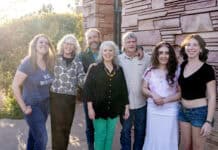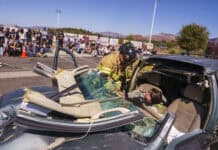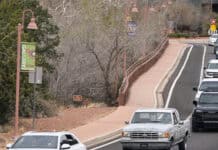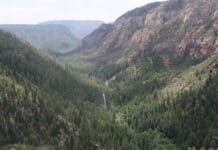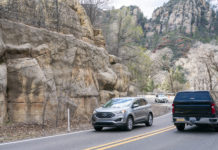Under the dark Sedona night sky Sedona Mayor Pud Colquitt and Councilwoman Nancy Scagnelli blindly made their way along the Hwy. 89A West Sedona corridor around 9 p.m. on Monday, Aug. 13.
Larson Newspapers
Under the dark Sedona night sky Sedona Mayor Pud Colquitt and Councilwoman Nancy Scagnelli blindly made their way along the Hwy. 89A West Sedona corridor around 9 p.m. on Monday, Aug. 13.
“You can’t even see the sidewalk in front of you,” Scagnelli said. “It’s really, really dark out there.”
Prior to Monday night, Colquitt said she’d never been a nighttime pedestrian on the highway.
“Up until that time I had no concept of what it was like,” Colquitt said. “I was really very surprised.”
Colquitt said the walk made her realize the issue isn’t just motorists not seeing pedestrians, but pedestrians not being able to see in the dark either.
Sedona City Council held a public work session Wednesday, Aug. 15, to talk about the Arizona Department of Transportation’s lighting plan, which included 76 streetlights to be staggered along Hwy. 89A between Airport Road and Dry Creek Road.
After ADOT showed the plan to council in June, residents — particularly Keep Sedona Beautiful — rallied to protect Sedona’s dark skies.
At the request of Councilman Rob Adams, council asked ADOT to stop the design process until council let the public share its ideas. ADOT complied.
At Wednesday’s meeting, council directed ADOT to continue looking at lights to improve safety on the corridor while also exploring other options — on-demand pedestrian lighting, a stoplight at Andante Drive and lowering Hwy. 89A’s speed limit.
Hwy. 89A history
ADOT looked into the safety of Hwy. 89A at the request of the city following three pedestrian deaths in the past two years.
In March 2006 ADOT attended the first council work session to talk about the corridor and agreed to do a safety study.
ADOT conducted the Sedona Pedestrian Crossing Study in June 2006 and gave the results to council Aug. 9, 2006.
The study said more pedestrian signs and additional lighting were needed.
Pedestrian signs were placed along the highway in August 2006.
ADOT presented a design, which includes 76 streetlights from Airport Road to Dry Creek Road, to council in June.
The design calls for high-pressure sodium light bulbs under cobra-head shades on 30-foot standard ADOT poles. The poles would be staggered 290 feet apart on both sides of the highway.
High-pressure sodium is currently used for all public lighting in Sedona, according to City Manager Eric Levitt.
Cobra-head shades are designed to direct light downward and are dark sky compliant, according to Chuck Gillick, ADOT Northern Region traffic engineer.
Keep Sedona Beautiful
KSB, who holds itself responsible for preservation of small-town character and proper stewardship, said 76 lights would damage Sedona’s dark sky.
Vice Mayor Jerry Frey asked KSB why members have a problem with lights on Hwy. 89A but not with 37 30-foot and 74 15-foot lights to be included in the Hwy. 179 Improvement Project.
KSB President Barbara Litrell, of Cornville, didn’t have an answer for Frey but said she would get back to him.
Litrell told council KSB wants a site-specific solution on Hwy. 89A.
Two of the three pedestrian deaths happened near Andante Drive. That’s where Litrell said the problem is.
Litrell offered four alternatives to ADOT’s streetlight proposal.
n A traffic light at Andante Drive and Hwy. 89A.
According to Litrell, more accidents occur in the day than at night and streetlights wouldn’t address daytime accidents. A traffic light would help 24 hours a day.
“A continuous river of light along Hwy. 89A does not answer the question we are faced with today,” Litrell said.
n Reduce the speed limit.
“Speed kills,” Litrell said.
KSB recommended ADOT lower the speed limit from 40 mph to 30 or 35 mph.
According to Litrell, at 40 mph, a pedestrian has a 20-percent chance of survival if hit. At 20 mph, a pedestrian has a 90-percent chance.
n Improve speed and pedestrian alert signs.
Litrell suggested signs that show motorists how fast they are traveling, such as those in construction zones, be put on Hwy. 89A.
n Public education.
Using local media outlets, Litrell believes an education campaign needs to be launched to teach safety to pedestrians and motorists.
ADOT
ADOT met with KSB before Wednesday’s meeting to address KSB’s concerns.
According to Gillick, ADOT still supports the 76 light plan but is willing to look into alternatives.
ADOT plans to study Andante Drive again in the near future to determine if a traffic light is needed at the intersection.
Gillick said ADOT has a signal-warranting criteria that includes eight components. At least one of the eight criteria has to be met before ADOT installs a signal. However, if one or more of the criteria are met, it doesn’t mean ADOT has to put a signal in.
“It is a judgement call,” Gillick said.
Lowering the speed limit doesn’t necessarily make people drive slower and puts a strain on police departments, Gillick said.
“Drivers operate their vehicles at a speed they feel comfortable with,” Gillick said.
Addressing the problem only at Andante Drive creates liability for ADOT in other areas. Lit crosswalks pose a similar problem.
“Where do you put those lighted crosswalks?” Gillick asked.
City Council
Adams assured residents the lighting plan wasn’t a “knee-jerk” proposal.
“This has been going on for quite some time,” Adams said. “We’ve been looking for solutions.”
It’s important for council and Sedona residents to think about the future, Adams said. There will be more development in Sedona, which means more traffic and pedestrians.
Both Colquitt and Scagnelli said after their stroll they believe there is a safety issue that needs to be addressed.
Councilman Harvey Stearn told ADOT he doesn’t feel lit crosswalks have been thoroughly considered.
“It’s not a new thing for the state of Arizona,” Stearn said. Tucson uses them and ADOT needs to look into what other city’s are doing.
Stearn also said he supports a lower speed limit.
“I do think that a lower speed limit is desirable on Hwy. 89A,” Stearn said.
ADOT now heads back to the drawing board to search for a solution that keeps Sedona’s night sky dark while also keeping pedestrians and motorists safe.
Trista Steers can be reached at 282-7795, Ext. 129, or e-mail to tsteers@larsonnewspapers.com.


